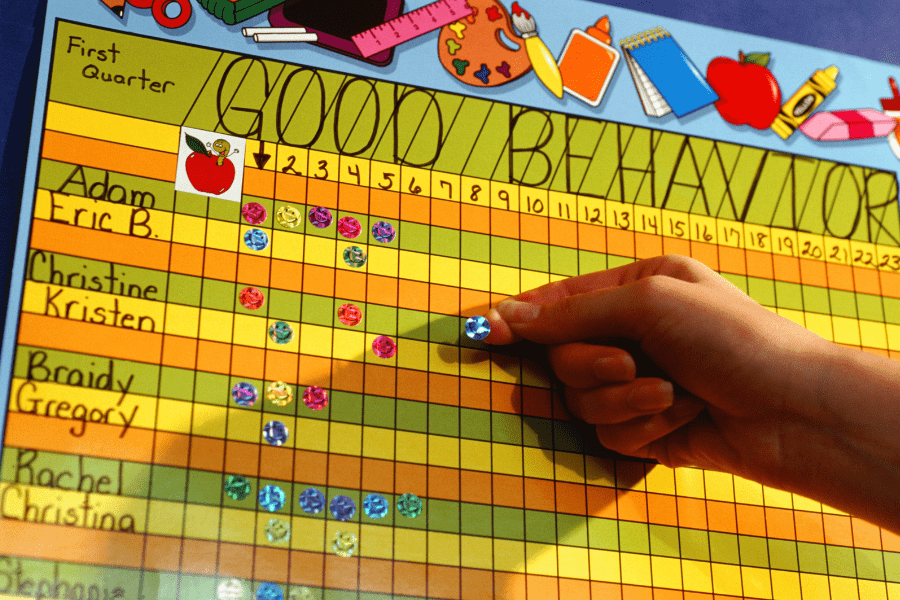 My first year of teaching was for a class of first graders. It’s an understatement to say that I was more apprehensive about implementing and maintaining classroom management than I was about teaching six year olds to read.
My first year of teaching was for a class of first graders. It’s an understatement to say that I was more apprehensive about implementing and maintaining classroom management than I was about teaching six year olds to read.
I was absolutely terrified.
Teach digraphs and diphthongs? No problem! Come up with a behavior chart, give consequences, and be consistent in my execution of this system — even though we’re told to individualize our instruction? Yeah, I was freaking out.
As a newbie, I spent so much time researching classroom management and behavior charts. I read the classics: Teaching With Love and Logic and Classroom Management That Works. I noticed that the consensus pointed toward redirection and private ways of charting student performance. Public displays of behavior tracking just didn’t seem to be ideal, but it’s all I knew.
>> RELATED READ :: 7 Tips to Improve Executive Function Skills for Texas Kids <<
Old Habits Die Many Colors
I grew up “changing my color,” i.e., a behavior chart. I have a vivid memory of being in kindergarten and changing my color, not once, but twice in one day. Why? Because I kept trying to balance a pillow on my head in the reading center. The fact that this memory has stuck with me for a quarter of a century goes to show how truly unnerving it was to my five-year-old brain.
After mulling it over, I decided to try the color system behavior chart when I set up my first grade classroom. Honestly, I really didn’t know how to implement anything else this early on in my teaching career. I just wanted my students to be good! I knew I would give warnings and second chances, but I still wanted a visual way to remind my class to keep it together . . . as much as six year olds can keep it together . . . when the warnings stopped working.
It lasted for about a month.
>> RELATED READ :: Encouraging Your Child with ADHD :: 5 Essential Roles for Moms <<
Color Envy Versus Classroom Management
The behavior chart became an obsession with my class. There were lots of tears. Not only did it become a fixation for these sweet babies, but some of the parents made a habit of walking into the room and craning their necks to look at the chart. They weren’t just eager to see what color their child earned; they wanted to see how the other kids in the class behaved that day.
Even though I had numbers listed and not names, they eventually figured it out. I would hear whispers: “Brandon got an orange. I wonder what he did?” They wanted all the juicy gossip, and let me tell you — children love to tell on their peers.
This system simply wasn’t private. I didn’t always have time to clear the colors before dismissal, and, to quote my three year old: “It wasn’t fair!”

Stickers of Shame or Badges of Honor?
Does the color system behavior chart work for some kids? Perhaps. Is it the best way to teach kids not to act like stinkerdoodles in the classroom? I truly don’t think it is. If we expect our students and children to be perfect all day, even if they’re having “one of those days,” then we should be changing our color, too.
We should be putting ourselves in time out.
We should be writing letters of apology to the people we’ve wronged.
We should have privileges revoked.
>> RELATED READ :: 4 Ways to Avoid the Summer Slide <<
I know what you’re probably thinking: We’re adults with enough stress in our day. We already have to follow laws, and we have certain expectations at our jobs. Who cares if we don’t follow common courtesy “rules?” We can be rude to people if we want, right? We can shame moms behind the veil of our phone screen. Why not roll our eyes at someone because she went to the store in pajama pants and slippers with her hair looking a hot mess? There are no consequences. There is no public shaming. “Oh my goodness! Sheila pushed past the elderly lady to get in the 10-items-or-less line first, AND she has 14 items! Change your color, Sheila!”

We All Behave the Rainbow
All of us make mistakes. I do — both as a mom and as a teacher — and I tend to overreact. I have impossible expectations, and I sometimes forget that these people in my care are small little humans.
They are learning about their world by testing limits, seeing what’s appropriate, and figuring out what it means to treat others with kindness. They don’t need the stress of worrying about what color is on their behavior chart for the day.
Maybe you have a public color system in your classroom; maybe you have one in your home. If it works for you, that’s great! But if you notice that it’s consuming your day and the day of your children, then I suggest you try something else:
- Try to communicate with your students and children about their behavior privately.
- Give them constant praise, redirection, and encouragement.
- Talk to the parents, then work as a team to create a positive learning atmosphere for their children.
Lastly, don’t forget to give yourself a break every once in a while when you do mess up. You are amazing, your students and/or children love you, and luckily, no one is ever going to ask you to change your color.











A-flippin’-men!!! I am not a fan of public color charts for my kid or in my classroom and that opinion was sealed when my kindergartener came home the second week of school, after several days on red, wailing because she was a “bad kid” and would be one forever. Break my mama heart!!!